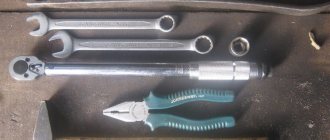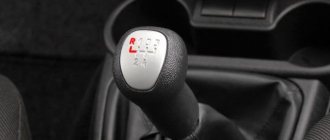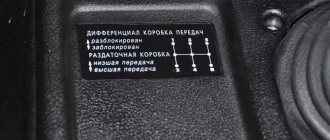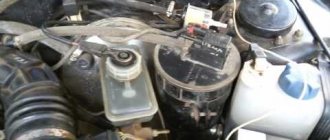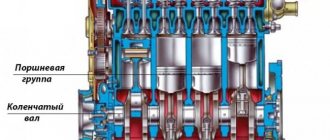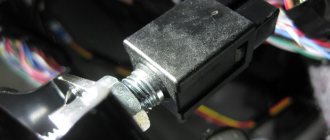Is it possible to disconnect without consequences?
When thinking about how to disable ABS on a Grant, it is important to remember: “arbitrariness” will lead to some questions during maintenance, which will be visible to the on-board computer technicians. When contacting service during the warranty period, the fact that ABS is turned off alone is the reason for refusal of free repair
How to carry out the procedure correctly?
First, open the mounting block where the fuses are located. It is located near the battery
Sometimes you have to remove the 15-amp fuse, but the car's instructions will help clarify this issue. Then the ignition is turned on briefly, and it is important that the brake system and ABS lights do not go out. After the sound signal, the ignition must be turned off. Then comes the removal of the block with the bottom cover
The electrical wire from the fuse is cut lengthwise and its ends are stripped to about 2 cm.
The problem of how to disable ABS can be easily solved: you will need a five-pin relay, which can be purchased at any auto store. A thorough study of the contact pattern will help carry out the procedure without negative results.
Work begins with winding contacts 86 and 85. It is necessary to connect the wire going to ground to them. The second wiring is responsible for supplying the signal. The contact marked “30” should connect to the wire coming from the fuse, while 88 should connect to the ABS. The shutdown button can be placed anywhere in the cabin.
FAQ
You can often hear the question “ How to disable ABS without removing the fuse, if such a function is not provided by the manufacturer?” " The only way to disable the system on the vast majority of cars is to disconnect the system's power supply circuit, which requires removing the fuse. There are no other shutdown options if there is no shutdown button in the cabin.
Another common question: “ Should ABS be turned off for the entire winter season? " If the reason for de-energizing the system is only the desire to shorten the braking distance on a winter road, then this is not necessary. For reducing the braking distance you will have to “pay” with loss of controllability, which is much more dangerous.
What is ABS
Subaru Forester 2.0 IS EyeSight Cross Logbook Classic Emblem for Forester
The anti-lock braking system was developed when it became clear that when the wheels suddenly jam, the car loses stability and is difficult to control. Moreover, the quality of braking did not improve, and the car was pretty much carried off the road. Therefore, a system was developed that, by regulating the pressure in the brake system pipes, allows the wheels to turn slightly. This significantly improves vehicle dynamics, allowing the driver to control the vehicle more confidently. But despite its apparent simplicity, this is a rather complex process that requires the coordinated operation of many mechanisms included in the anti-lock braking system. If any of the components fails, a warning lamp lights up on the instrument panel.
Important! You can often hear the question from drivers: “Why is the ABS sensor on?” It is important to know that when the warning light comes on, it does not necessarily indicate a faulty wheel sensor.
How to modify the design
To protect the wiring harness from the environment, you can use a D-shaped seal. We lay the wires in it and wrap it with electrical tape. We put everything in the corrugation. We glue the cover covering the ABS sensor connector around the perimeter with the same sealant. This will prevent moisture and dirt from entering the area where the sensor and connector are located.
Attention! If the ABS fails, the brakes remain operational, but the braking efficiency is reduced, which is especially dangerous on some surfaces. See why.
Why pneumatic
Communities Lada Priora Lada Priora Club Blog Ignition switch wires
Braking requires quite a lot of effort from the driver. Making such an “injection” and bleeding the brakes on four wheels at once is not an easy task. Therefore, a solution was found: due to the vacuum in the intake system, a special mechanism, a vacuum, greatly facilitates this process. And the pedal is quite easy to press.
Important! It is the system, operating on the “syringe” principle, with many rubber seals, that requires the complete absence of air in the system, since its presence reduces the efficiency of the brakes to zero.
Simply put, due to the difference in the density of air and brake fluid, instead of uniform pressure on the piston of the working cylinder, there will be a chaotic movement of air bubbles inside the system. Because of this, they sometimes need to be pumped.
Bringing the control unit to life
Communities DRIVE2 Audi Club Blog Which S tronic is installed on which models
Failure to operate the unit is a consequence of contact burnout, which is caused by increased voltage. The second reason that there is no contact is mechanical or chemical influence. With a thoughtful approach, repairing the ABS unit is simple. Having conveniently positioned the part on the workbench, you need to carefully open the body using a construction knife. You shouldn’t run it too deep, otherwise you can damage the electrical wires.
Having identified the break point, using a pulse soldering iron, the damaged wires are resoldered. You can use a Weller soldering station. It is not recommended to overheat the ceramic base to avoid damaging the board. A damaged board will require replacement. After this, all that remains is to assemble the block and install it back.
The problem is not always the block. Sometimes you have to change the sensors located on the rims. If you want to restore the functionality of the old device yourself, without resorting to installing a new one, it becomes necessary to rewind the coil built inside the sensor. The work of restoring the system is thankless, so it is recommended to contact service centers. This will save a lot of effort, nerves and money.
Anti-lock braking system ABS
| GENERAL INFORMATION |
As special equipment, the VW T4 has the BOSCH anti-lock braking system (ABS). Additional installation of ABS is not possible. ABS prevents wheels from locking during hard braking. As a result, the car remains controllable during full braking. ABS works as soon as the ignition is turned on and the driving speed is 5–7 km/h. It regulates all braking processes in the locking area as soon as the speed exceeds 12 km/h. Thanks to speed sensors, two on the front and rear wheels, the speed of rotation of the wheel is measured. By analyzing the signals from individual speed sensors, the electronic control unit calculates the average speed, which corresponds approximately to the average speed of the machine. By comparing the rotational speed of an individual wheel with the average rotational speed of all wheels, the control unit recognizes the slipping condition of an individual wheel and can thereby detect the condition of the wheel shortly before it locked. The possibility of wheel locking means that the brake fluid pressure in the corresponding brake mechanism is too high in relation to the adhesion of the wheel to the road, in this case the hydraulic system, receiving signals from the control unit, maintains the fluid pressure constant. Namely, the pressure in the brake mechanism does not rise, even if you press the brake pedal harder. If the possibility of blocking persists, then the fluid pressure decreases when the release valve opens, but only enough so that the wheel accelerates slightly, then the pressure is again maintained constant. If the wheel accelerates above a certain value, the pressure is increased again by the hydraulic system, but not higher than the total brake pressure. This operation is repeated during hard braking for each individual wheel until the brake pedal returns to its original position or shortly before the vehicle comes to a complete stop. A safety device in the electronic control unit ensures that the ABS switches itself off in the event of a malfunction (for example, an open circuit) or the on-board voltage is too low (battery voltage less than 10.5 V). In this case, the ABS warning light on the instrument panel lights up while driving. The normal braking system remains operational. The car behaves when braking as if ABS was not installed. If the ABS warning light comes on while driving, this is a signal that the ABS system has been disabled. In this case, you should: – stop the car for a while, turn off the engine and start it again; – check the battery voltage; – if the voltage is below 10.5 V, charge the battery.
Warning
If the ABS warning light comes on when you start driving and goes off again after a while, this indicates that the battery voltage was initially too low, but then increased as a result of recharging from the generator.
Examination
| EXECUTION ORDER |
| 1. Check the tightness and good contact of the battery terminals. |
| 2. Place the car on trestles, remove the front wheels, check the electrical wiring of the speed sensors for external damage. |
| 3. Further checks should be carried out at a service station. |
| Warning Before welding work with an electric welding device, it is necessary to disconnect the plug from the electronic control unit (installation location: behind the trim of the driver's door pillar. Disconnect the plug only with the ignition off, do not start driving with the plug disconnected. When painting and varnishing, it is allowed to expose the control unit to short-term temperatures up to + 90 °C and long-term (about 2 hours) up to + 85°C. |
Logbook VAZ 2170 (2012)
ABS test in winter.
Disappointed in Prior's ABS. The first snow fell, we didn’t have time to change the wheels, we have Belshina all-season tires. So braking with them brought unpleasant surprises. On snow, as well as on ice sprinkled with snow, braking is weak! Really scary even. I decided to compare what it would be like without this electronic gadget =)) To do this, I removed the cover of the mounting block and pulled out the ABS fuse. The result was unexpected - it turned out that the tires were not so bad. I took measurements and braked on packed snow at a speed of 50 km/h (according to the speedometer). So, with the ABS turned on, the car went as much as 18 steps (!) further. Although without ABS it turned slightly, it was better than 15 meters of braking distance. I made several attempts both with and without ABS - the difference is about the same. I'll check it later with winter studded tires.
- More about this car:
- Logbook
- Reviews
- Break (more precisely, jump) of the timing belt
- New VAZik))
- Mileage under one hundred
So everything is fine, ABS usually lengthens the braking distance, but theoretically you can go around the obstacle... because control will not be lost...
It’s not Prior’s ABS fault, that’s how all ABS work. On a striped road, even on asphalt in the summer, when going around an obstacle and braking, the braking distance greatly increases.
SO, almost the same budget car as the Priora is worn out... On the Loganovod forum there are the same problems - because... It seems to have the same ABS as on the Priora..
I haven’t driven a middle-class car, but I don’t think that the Camry or Passat have the same garbage
“if she chirped, then it would begin to start, otherwise, without her, you would already be in a complete mess”
from 40 to 50 it’s tedious to slow down, of course, but it’s not particularly difficult to hold on and you stop earlier. At 80 I tried to brake there, yes, I have to fight the fact that the rear is trying to overtake the front. Apparently the point is that there is no sorcerer on cars with ABS
+1. That's how it is.
All modern cars have 4-circuit ABS, and the ABS unit itself is responsible for the distribution of braking forces.
I don’t know how it is on Logan, but on Stepway the ABS is different than on regular Logans and Sanders. Next generation..
Maybe we just started making our own at VAZ again and the ABS has the same problems as the EUR??
With the electronic gas on 2114, I experienced the glitch the hard way at an oncoming (crossroads) stalled and started. If you press on the gas, it stalls. Somehow we made it to the side of the road, removed the terminals from the battery, and then performance was restored. But the memories are not good...
no, everything is fine with the ABS, it doesn’t throw, I meant that when the ABS is turned off, the “electronic sorcerer” is also turned off, but the usual one is not there. That is, with ABS turned on, the braking distance is longer, but with ABS turned off, braking above 60 requires stopping the car
ABS greatly lengthens the braking distance on tires that do not correspond to the season. And on the corresponding one it increases a little or even reduces it. I'm still not quite used to abs. When emergency braking, first, as per the old school, you brake as hard as you can so that the wheels don’t lock, and then as hard as you can so that the rear wheels also work.
This is fine. A friend of mine completely crashed her car because of ABS. She didn’t let me brake properly. Ford Fusion.
and Belshina is still guano.
And why does everyone think that if braking is ineffective with ABS, it would be effective without it?
There are cases when ABS extends the braking distance. But in the OVERWHELMING majority of cases, it reduces it, sometimes quite significantly.
Psychologically, yes, it is a strong feeling when you press on the pedal, but the ABS does not block the wheels and the car continues to move. But I also have similar non-ABS memories, when you press on the brakes, the wheels lock, but the car doesn’t care, it just keeps going without slowing down.
My psychological feelings in this case were confirmed by the measurements)) 18 steps of difference somehow does not add optimism)) Okay, 3-5, it can be attributed to an error..
The manufacturer should make a button to turn it off, but so that the brake force distributor does not turn off
The main button is in the head. It has been spoken and renegotiated.
And without it, ABS of any generation will not help.
My psychological feelings in this case were confirmed by the measurement)) 18 steps of difference somehow does not add optimism)) OK, 3-5 would be fine, it can be attributed to an error.. The manufacturer should make a button to turn it off, but so that the brake force distributor does not turn off
And I didn’t say that it’s always less.
By the way, somewhere I came across old tests (which have now largely lost their relevance), so there the braking distance depended on the tires on snow and ice to a much greater extent than on the presence or absence of ABS. And it seems that your case was also there: on unsuitable tires, the braking distance with ABS was much longer.
And on the button. I have ABS and, accordingly, no brake force distributor. ABS fulfills its role. Those. If I turn off ABS, then all my wheels will brake equally.
So for this, you need to choose the right speed mode.
The wheels are blocked, but the car doesn’t care, it continues to drive without slowing down.
Ha - I remember going down a hill on 099 into the ice: on the first one without gas it goes 20 km/h, and as soon as you touch the brake the wheels lock and the car starts to accelerate
On the 1st I had to carefully rub against the curb and brake against it
We were shocked during the test drive of the Polo when we decided to brake clearly after acceleration))), the fence was almost demolished))), the manager was in a trance)))). You can't figure out the distance. Need to train)))
I rode the Belshina-100 through two Siberian winters, it’s not studded, of course, but it never skidded and never skidded.
Vases, Logans and Polosedans have 3rd generation BOSCH ABS. Now Europeans use the 5th and 6th generation. So it has one drawback - it greatly relieves the brakes. Sometimes, in a critical situation, the pedal becomes stuck, and the car flies to the “target” without brakes. This feature is especially evident on the comb and the “washboard”. The treatment is simple - you release it and press the brake again, and the glitch disappears. It’s strange, but the car manual doesn’t say a word about this feature. I found the information by chance on the Internet, tried it out and no problems. But in winter you don’t have to bother releasing the brakes, just put the pedal to the floor, and then it will figure out how to reduce the speed as efficiently as possible. In winter, after Kalina with ABS, I’m really scared to drive to Rio without it.
What is this 3rd generation?
The Sandero Stepway and the latest Priors have 8th generation ABS with EBA and EBD. On the latest eighth generation ABS, the blocks recognize the type of support surface by relative slip and allow the wheels to be locked.
It's nice to know that the Logans and Priors have the same electronics as the geldings and bekhs. At least this explains the wild prices for them.
Well, what can we do with ..8.1 there, and the 9th generation is already installed on new cars and geldings, by the way, AvtoVAZ dreams of putting it in the grant, although it is silent about how this will affect the price!
Well, my 2-year-old Kalina has the 3rd generation. And exactly the same block is installed on Vsevolozhsk Polos and Avtofamov Logans. And he migrated to Largus without changes. On Grant with automatic transmission it’s the same HE. And all these cars have the same problem - involuntary blocking of the brake pedal in a critical situation. But they really want to install the 5th generation with ESP and EBD on NewKalina. But when will this be?
I seriously doubt that VAZ will have the courage to bet on its crafts with-we-without-ti from modern luxury sedans. Moreover, this will raise the price by 1000-1500 Euros, because... There are about fifty expensive sensors there.
“The Sandero Stepway and the latest Priors have 8th generation ABS with EBA and EBD”
Not on all Priors.. Only in the Luxury configuration. On the rest - no EBD
I don’t know how that ABS with EBD works, I haven’t driven it
Well, I don’t know..that means only for Prira luxury
What 3rd generation ABS are you talking about, people?? Bosch 8th generation ABS+BAS is installed on priors and grants with abs. And I don’t know what generation the Kalinas are, but just ABS, without BAS.
What is ALS? Break assist? So she’s only going for luxury ones, in the summer I literally studied the price lists
Yes, break assist. Here are the links: all Priors and Grants with abs have brake assist, but Kalinas do not, even luxury ones. Here are the links:
As we see on the cheapest Grants and Priors with abs, there is also bass. But even the most expensive Kalinas don’t have it.
Yes, it really is written like that. .But in the summer my father took a Priora, so there were only suites with ALS.. Or the managers in 2 salons did not have the information and she still has ALS
What generation are you talking about here?
If people, judging by the review, do not even know what ABS is, why and how it works.
So, with the ABS turned on, the car went as much as 18 steps (!) further.
Author, the main task of ABS is not to shorten the braking distance, but to prevent the car from skidding with the wheels locked. If one or more wheels slip, you lose control of the car and skid, so that this does not happen and the ABS chirps, preventing you from blocking the wheels and braking equally with all four!
Ideally, ABS does not lengthen the braking distance; if you really need an honest experiment, then change into winter tires and repeat the measurements.
I remember when I was studying at a driving school (I studied conscientiously), on the topic of “braking” they told me that on a car without ABS in areas of ice, compacted crust, etc. You need to brake with sharp, frequent intermittent movements (actually simulating ABS) to avoid skidding. Yes, if the brakes do not skid when the pedal is pressed, the braking distance will be shorter than when braking with intermittent presses.
The test was either in a car review or while driving... On a car without ABS they tried to brake with “imitation ABS” and stupidly skidding.. Stupidly skidding turned out to be shorter
.. Perhaps the fact is that a racing driver needs to brake with short presses..
I saw such a person, a man who drove VAZs without ABS for a very long time, of course. It’s not just about driving quickly, but you also need to feel the car, and this is only many years of experience.
Stupidly it turned out shorter
This is only on snow, or on spikes - then the wheel “buries” and creates a “mound” in front of itself. On ice and without spikes, you will fly away like on skates
